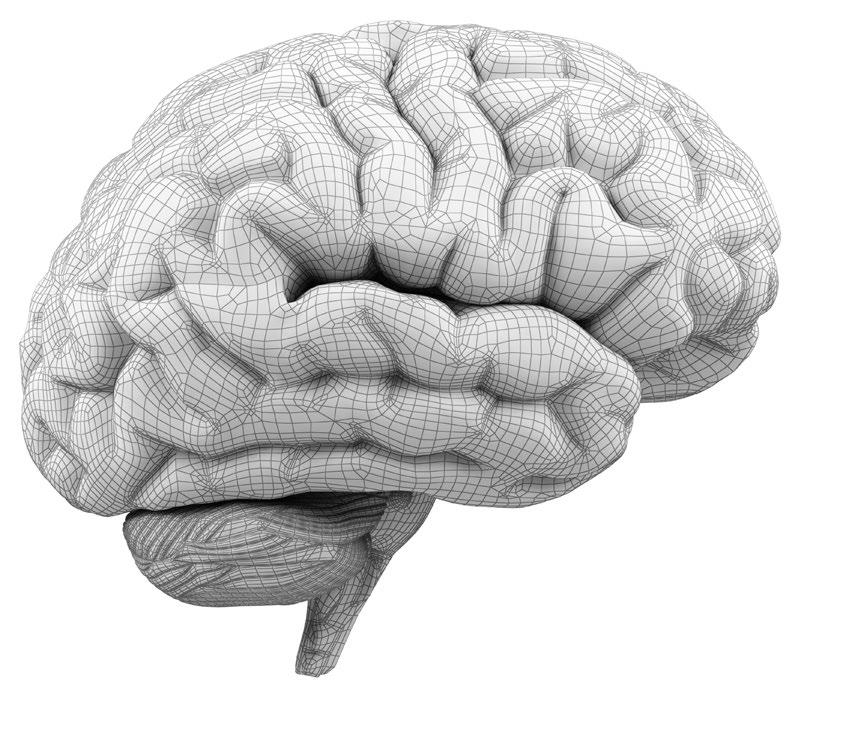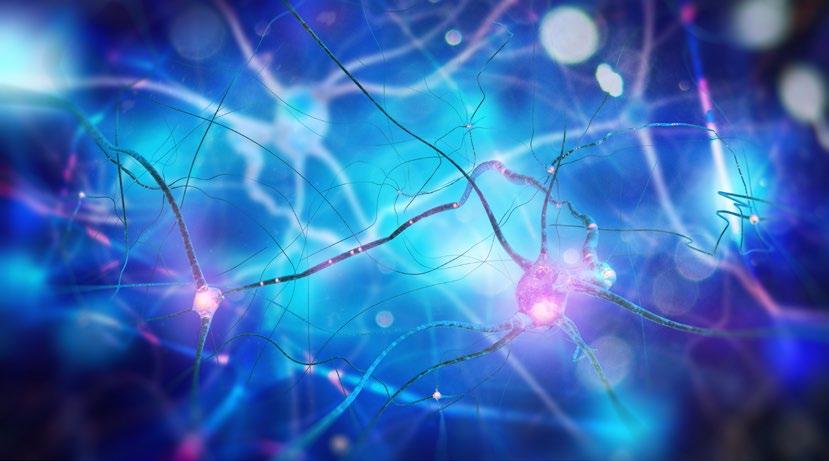
9 minute read
Our brain: an individual universe in constant metamorphosis
We, living beings, are robust systems with a series of emerging properties giving substrate to such robustness. We have both structural and functional redundancy, allowing us to modify or replace certain elements or interactions from one moment to the next. On the other hand, we have error prevention, reduction, and correction mechanisms, an important and determining aspect of the strength of a biological system, and a sine qua non-characteristic for the evolutive success of living organisms.
These characteristics are of enormous value since they allow us to respond adaptively and predictively to changes in the environment, given the potential of recording stimuli, storing, and using them to elaborate the best possible predictive adaptive responses to new environmental demands. In this scenario, memory, perception, and learning result critically since they "dwell" in our brain, an extremely flexible organ that allows constant metamorphosis. In this Kafkaesque landscape, epigenetic mechanisms, which include DNA methylation, histone post-translational modifications, and noncoding RNA molecules, are involved in the regulation of gene expression, cell differentiation, and development in almost all tissues, including, of course, our brain, where epigenetic mechanisms show their greatest variability and diversity. These epigenetic brain mechanisms (neuroepigenetic) are critical for higher cognitive functions such as memory and learning. Thus, it is not surprising to find that the deregulation of such epigenetic processes is related to different neurodegenerative disorders and conditions.
Advertisement

BRAIN PLASTICITY AND NEURODEVELOPMENT
The development and maturation of our brain are exquisitely regulated processes that begin during embryogenesis and continue to varying degrees until late in life. Our brain never stops changing! Thus, after birth, during the first years of life and adolescence, a blast of new intraneuronal connections (synaptogenesis) is observed, followed by the elimination of a large number of synapses (synaptic pruning). , , This dynamic structural remodeling of synapses and neural networks can be interpreted as the structural manifestation of brain plasticity dependent on experience memory and learning, and the alteration of these processes can trigger several behavioral disorders or neuropsychiatric disturbances.
Advances made in recent years in the field of neuroscience have allowed us to overturn long-held beliefs about our brain. For example, we assumed that the adult brain was a structure unable of carrying out significant structural remodeling processes. This belief assumed that there was no neurogenesis in the adult brain and that all structures of the nervous system, and especially, the synapses, had formidable stability, with little potential of structural dynamism. However, the vision of our brain has undergone an evolution almost impossible to have anticipated a few decades ago, it changed dramatically to the point of recognizing today the existence of huge flexibility in both terms of structure, as well as neuronal function in the adult brain. Nowadays, we recognize as an unobjectionable fact the existence of neurogenesis in the adult brain, just as we now acknowledge that neurons and synapses undergo different forms of structural remodeling, underlying structural and functional plasticity, allowing deep changes in the intimate cerebral structure. Undoubtedly, this formidable brain plasticity has a relevant adaptive value, resulting from a complex and reciprocal relationship between structure, stimuli, and memories.6
NEUROEPIGENETICS
Brain is a superb organ in both plasticity and diversity, containing many interconnected neuronal and non-neuronal cell types (glia or synneurons ) with unique functions, which undergo coordinated development and maturation in space and time. Neurons are postmitotic cells with an extremely long lifespan that, nevertheless, adapt and respond rapidly to highly changing environments, while maintaining their hemostatic state and undergoing further functional specialization. In these terms, gene expression has been shown to underlie synaptic and neuronal activity and is regulated by a range of epigenetic mechanisms, some of which are almost absent in other types of cells and tissues of the body.8
Results indicate that the different epigenetic modifications of the brain occur as a consequence of the several environmental stimuli it receives, establishing a bidirectional (reciprocal) relationship, enabling an almost infinite myriad of results, evidencing its complex and dynamic nature, which evolves without a rigorously pre-established path. In this complex scenario, the activation or silencing of genes controlled by epigenetic mechanisms represents that crosstalk that emerges from the perturbation of the structure towards energy (stimuli), within a contextual environment that evolves as a result of new solutions, a constructive/destructive interference capable of modifying and regulating synaptic potential, memory, and learning.
A UNIVERSE OF POSSIBILITIES
Among epigenetic modifications, DNA methylation corresponds to how our DNA is epigenetically modified, and initial studies focused on the canonical form of methylation, which belongs to methylation of cytosines followed by guanines (CpG). This is the predominant form of DNA methylation in most cells and tissues studied. However, the brain shows an almost inexistent variety in other cell types, giving the brain tissue an epigenetic richness, allowing the regulation of brain gene expression, a complex and diverse mechanism, enabling a huge range of "solutions" to the different stimuli we face every day.
Thus, the neuronal methylome (methylated neuronal DNA) is especially diverse, being not only the tissue where we observe the highest levels of oxidation of methylated CpG sites, but also the tissue where we find the highest percentage of methylations in non-CpG sequences (CpH; where H represents
other nitrogenous bases – Adenine, Cytosine, or Thymine). It seems that DNA methylation could be compared to a language of several colored flags, where each color and pattern of colors fulfills a specific function, with non-CpG methylation being more flexible and subject to editing dependent on the changing stimuli we experience daily. Indeed, for this to work in the manner proposed, the synaptic activity would have to be associated with neuronal nucleus activity, and that is what actually occurs.
Currently, there is a full consensus that experience-dependent plasticity is activated when neuronal excitation stimulates cell signaling pathways from the synapse to the cell nucleus, impacting the expression of different genes involved in processes linked to learning and memory. In this scenario, neural activity can strengthen or weaken synaptic networks by weighting existing circuit connections, while changes can create new neural connections, interlinking with each other like nodes in a three-dimensional/dynamic system with a large capacity of interconnections (alternative paths), allowing robust solutions to unpredictable situations.

SOMATIC MUTATIONS: A WORLD OF UNEXPECTED POSSIBILITIES
Somatic mutations can arise as single nucleotide substitutions, transpositions, insertions, deletions (including copy number change), and aneuploidies. These events appear randomly and are potentially caused by a range of different mechanisms. Some of the mutational mechanisms may developmentally specific while others may constantly add new mutations throughout life in a clock-like fashion. The rate and propensity of somatic mutations may also differ between genes and gene sequences.9 Interestingly, despite the assumption that such mutations are stochastic, new evidence points to the fact that some somatic mutations may be "programmed", as in the case of somatic hypermutation involving immunoglobulin genes in B-lymphocytes.10
Similarly, DNA methylation is unique among the other epigenetic mechanisms impacting the chromatin structure, since cytokine methylation carries an unknown evolutionary consequence,
accounting for the existence of increased mutability. For example, the rate of point mutations (SNPs) from cytosine to thymine (C>T), by deamination, is 10 to 50 times higher in methylated cytosines.11,12 An observation that goes hand in hand with increased mutability is that genomes with DNA methylation, in general, show a depletion of CpG dinucleotides, reflecting the occurrence of DNA methylation-induced mutations. This background has led some researchers to hypothesize that plastic variation (phenotypic plasticity) may foreshadow genetic variation, which, in turn, may contribute to the genomic fixation of environmentally induced traits in subsequent generations. In other words, it seems that our experience would not only impact our brain epigenome but could be fixed as mutations.13
There is increasing evidence that each brain is a unique myriad representing a population of genetically different cells.14 In short, our individual diversity resides in our cerebral individuality.
Mauricio Hidalgo Ortega

Bachelor's degree in Biological Sciences from the Pontificia Universidad Católica de Chile. PhD. in Biology by the Universidad de Chile. Independent researcher in Biopsychosocial Epigenetics and Neuroepigenetics.
References:
1. PETER R., H. Synaptic density in human frontal cortex — Developmental changes and effects of aging. Brain Research, 163(2), 195–205. (1979). doi:10.1016/0006-8993(79)90349-4
2. GIEDD, J. N., BLUMENTHAL, J., JEFFRIES, N. O., CASTELLANOS, F. X., LIU, H., ZIJDENBOS, A., Y RAPOPORT, J. L. Brain development during childhood and adolescence: a longitudinal MRI study. Nature neuroscience, 2(10), 861-863. (1999).
3. URBÁN, N., AND GUILLEMOT, F. Neurogenesis in the embryonic and adult brain: same regulators, different roles. Cell. Neurosci., vol. 8, (2014). doi: 10.3389/fncel.2014.00396
4. ZHAO, X., VAN PRAAG, H. Steps towards standardized quantification of adult neurogenesis. Nat Commun 11, 4275 (2020). https://doi.org/10.1038/ s41467-020-18046-y
5. STUCHLIK, A. Dynamic learning and memory, synaptic plasticity and neurogenesis: an update. Frontiers in Behavioral Neuroscience, 8(April), pp. 1–6. (2014).
6. LESLIE, JH AND NEDIVI. E. Activity-regulated genes as mediators of neural circuit plasticity. Progress in neurobiology, 94 (2011), 223-237.
7. DUQUE-PARRA, J. E., BARCO-RÍOS, J., & BARCO-CANO, J. A. (2021). El Término Glía, una Tradición Conceptual Errada: Propuesta de Cambio por Sinneuronas. International Journal of Morphology, 39(2), 638-641.
8. CAMPBELL, R. AND WOOD. M. How the epigenome integrates information and reshapes the synapse. Nat. Rev. Neurosci., 20 (2019), pp. 133-147, 10.1038/s41583-019-0121-9
9. HODGKINSON. A., AND EYRE-WALKER, A. Variation in the mutation rate across mammalian genomes. Nat Rev Genet. 12:756–66.(2011). doi: 10.1038/nrg3098
10. BRINEY, B.S., AND CROWE, J. E. Secondary mechanisms of diversification in the human antibody repertoire. Front Immunol. 4:42. (2013). doi: 10.3389/ fimmu.2013.00042
11. DUNCAN, B. K. AND MILLER, J. H. Mutagenic deamination of cytosine residues in DNA. Nature 1980 Oct 9;287(5782):560-1. doi: 10.1038/287560a0.
12. SVED, J., AND BIRD, A. The expected equilibrium of the CpG dinucleotide in vertebrate genomes under a mutation model. Proc Natl Acad Sci U S A. 1990 Jun;87 (12): 4692-6. doi: 10.1073/pnas.87.12.4692.
13. KUSMARTSEV, V., DROŻDŻ, M., SCHUSTER-BÖCKLER, B., & WARNECKE, T. Cytosine Methylation Affects the Mutability of Neighbouring Nucleotides in Germline and Soma. Genetics, genetics.303028.2020. (2020). doi:10.1534/ genetics.120.303028
14. SEKAR, A,, BIALAS, A. R., DE RIVERA, H., DAVIS, A., HAMMOND, T.R., KAMITAKI, N., ET AL. Schizophrenia risk from complex variation of complement component 4. Nature. (2016) 530:177–83. doi: 10.1038/ nature16549.










